Orthodontist In Tehran
Choosing a skilled orthodontic specialist marks the beginning of your treatment journey, and it is essential to recognize that we are deeply attuned to your concerns as an orthodontic patient. We fully comprehend the anxieties that may arise when embarking on orthodontic treatment, and making the right decision can address two key concerns:
- You may have encountered negative experiences in the past due to visiting unqualified or inexperienced dental practitioners.
-
You may still feel uncertain about whether the investment in orthodontic treatment will lead to the desired and satisfying outcomes.
As specialists in orthodontics, we are uniquely positioned to serve as a trusted source of information, guiding you through every step of your treatment journey and helping you achieve a radiant, confident smile. If you or a loved one are facing dental concerns, we encourage you to carefully consider this information. Making an informed decision about your orthodontic care is one of the most significant choices you can make, and selecting the right specialist is key to realizing your ideal smile. Let us support you in this important process and help you attain the results you deserve.
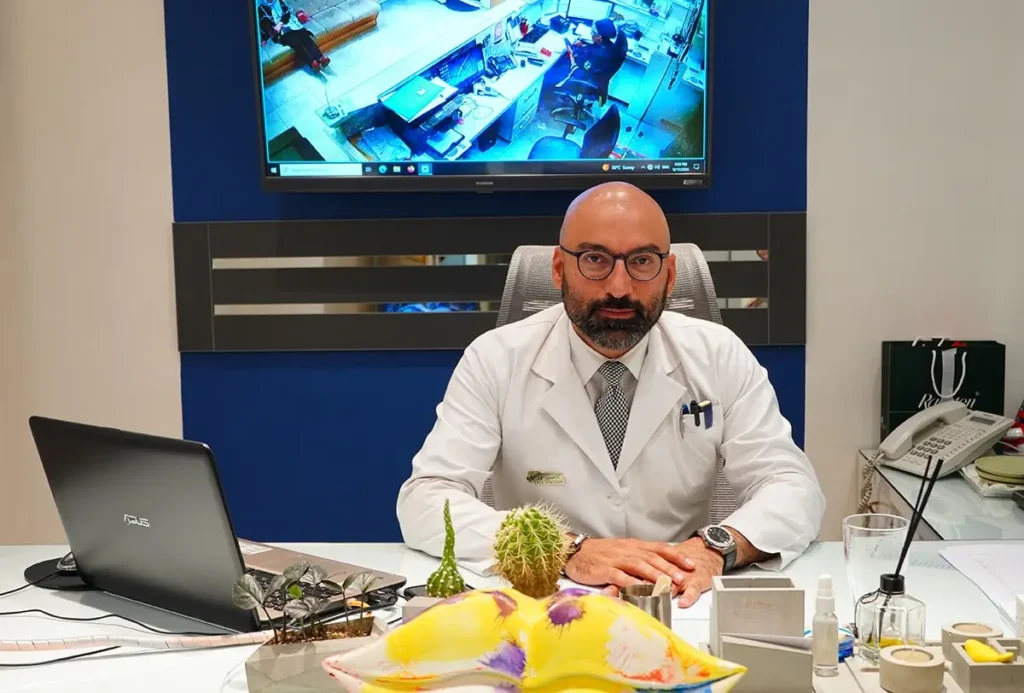
I am Dr. M. Davoudian, the head of Simadent Clinic. As an orthodontist, my primary role is to diagnose, prevent, and treat dental and jaw alignment issues, with a particular focus on conditions such as overbites, underbites, crowded teeth, and jaw misalignments. My goal is to help patients achieve healthy, straight teeth and a properly aligned bite. This process involves utilizing advanced tools such as braces, clear aligners, and retainers to gradually guide teeth into their ideal positions. In essence, my work goes beyond just examining your teeth—I ensure that your entire oral structure fits and functions harmoniously, resulting in a healthy, confident smile.
Who is an orthodontist
An orthodontist is a dental professional who begins their journey by completing general dental training and, after passing a specialized exam, advances into an orthodontic residency program. This extensive education spans a total of 10 to 11 years, equipping orthodontists with the skills to not only practice general dentistry but also to specialize in the prevention, diagnosis, and treatment of facial and jaw irregularities, as well as various dental misalignments.
Interestingly, the roots of orthodontic treatment trace back to ancient Egypt, around 500 BCE, where archaeologists have discovered mummies with dental appliances, highlighting the long-standing importance of dental aesthetics. As such, an orthodontic specialist is not only a highly trained expert but also an artist—skilled in transforming dental irregularities into beautifully aligned teeth through carefully crafted treatment plans. Their work combines technical precision with an artistic touch, ensuring both functionality and aesthetic appeal for a confident, healthy smile.
Orthodontist vs. Dentist : Making the Right Choice
While every orthodontist is a dentist and capable of performing general dental procedures, not every general dentist is qualified to be an orthodontic specialist.
General dentists are highly skilled professionals who excel in providing routine dental care and addressing primary oral health concerns. However, they do not undergo the formal academic training required to specialize in fields such as orthodontics.
Orthodontists, on the other hand, complete additional years of specialized education and training focused on diagnosing, preventing, and treating dental and facial irregularities. This advanced expertise enables them to offer tailored solutions for issues like misaligned teeth, bite problems, and jaw irregularities. When it comes to orthodontic care, choosing a specialist ensures you receive the highest level of expertise and precision for achieving optimal results.
.

Selecting the right orthodontic specialist is a critical decision, as the right choice ensures the success of your treatment and allows you to enjoy a beautiful, healthy smile for a lifetime. Dr. Masoud Davoudian stands out as an exceptional choice for several compelling reasons, including:
- Up-to-Date Technical Expertise: Dr. Davoudian stays at the forefront of orthodontic advancements, utilizing the latest techniques and technologies to provide effective and modern treatment solutions.
- Accessible Care: Patients have easy access to Dr. Davoudian throughout their treatment journey and even after its completion, ensuring continuous support and guidance whenever needed.
- Unmatched Precision and Attention to Detail: Dr. Davoudian is known for his meticulous approach, delivering high-quality orthodontic care with exceptional precision to achieve optimal results.
- Lifetime Follow-Up and Free Check-Ups: Dr. Davoudian is committed to the long-term success of your treatment, offering lifetime follow-up care and complimentary check-ups even after your orthodontic treatment is complete.
By choosing Dr. Masoud Davoudian, you are not only investing in a skilled and dedicated orthodontic specialist but also in a lifetime of confidence, comfort, and a radiant smile. Trust Dr. Davoudian to guide you through every step of your orthodontic journey with expertise and care.
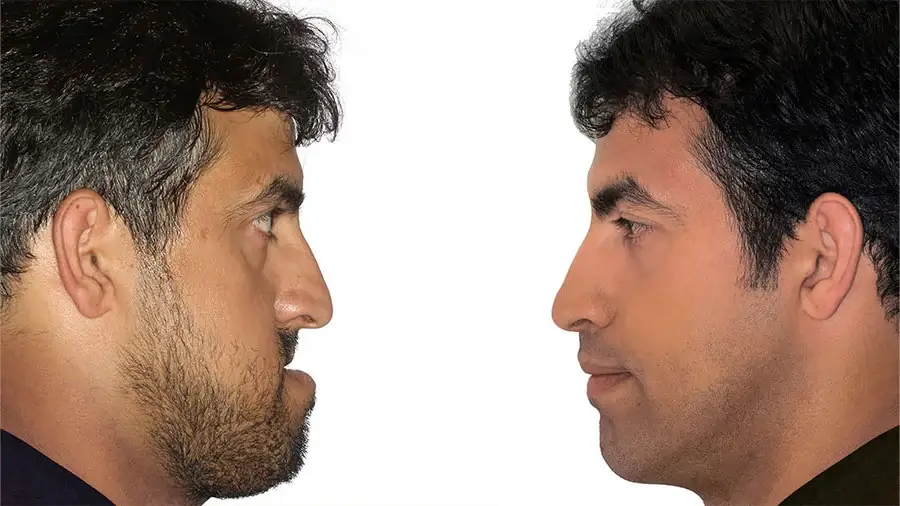
What dental abnormalities does an orthodontist correct?
The treatment of various dental and jaw abnormalities is the responsibility of an orthodontic specialist. An orthodontist is trained to diagnose, treat, and even prevent all types of dental irregularities, regardless of age, from childhood to adulthood. It is worth mentioning that in treating some serious dental and jaw problems, in addition to orthodontic treatment, jaw surgery may also be required, a process known as orthognathic surgery.
Dental and jaw abnormalities come in many forms and include various misalignments of the teeth and jaws. Like many others, you may think that an orthodontist only addresses issues such as crooked or misaligned teeth, but dental irregularities, determined by the positioning of the upper and lower jaws in relation to each other, are more complex issues. These are treated with the skilled hands of an experienced orthodontist. Bite and occlusion refer to the relationship and coordination between the upper and lower jaws and teeth. Any abnormality that disrupts this relationship and coordination between the upper and lower jaws and teeth is known as a “malocclusion.”

Large Gaps Between Teeth
In dental science, a gap of more than 0.5 millimeters between any two teeth is considered abnormal and a form of irregularity. If the gap is only between the two front teeth and the rest of the teeth are in good alignment, it is recommended to treat it with methods such as crowning.
However, if the gap between all teeth is larger than normal, more serious and comprehensive treatment is necessary. The best solution for this abnormality is orthodontics, which permanently eliminates the extra space between the teeth. With orthodontic treatment, the excess space is shifted toward the back of the jaw, where it is no longer visible, thus improving the appearance of the teeth.
Since gaps between teeth tend to widen with age, it is advisable to address this issue in a timely manner. Doing so not only enhances appearance but also resolves speech problems that may arise from this condition.
Crowded and Overlapping Teeth
Crowded and overlapping teeth, which are a direct result of jaw size abnormalities (typically small jaws), are one of the most common reasons for orthodontic treatment. Additionally, large teeth can also cause misalignment and overlapping. Crowded teeth can lead to further complications, including difficulties with speaking and eating, as well as subsequent issues such as gum inflammation and the development of impacted teeth, particularly impacted wisdom teeth.
One of the best treatment options for addressing crowded teeth is traditional fixed orthodontics, which effectively treats all levels of crowding, from mild to severe, in the best possible manner.
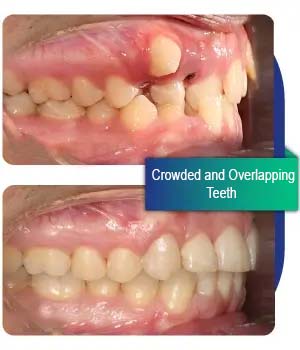
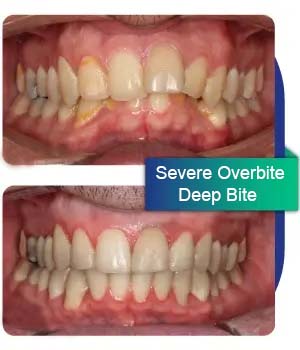
Severe Overbite (Deep Bite)
In a normal bite, the upper jaw should be slightly ahead of the lower jaw, with the upper front teeth positioned about one to two millimeters in front of the lower front teeth. When the overlap of the upper front teeth over the lower front teeth exceeds the normal range, it is referred to as an excessive overbite or deep bite.
If a deep bite is not treated with orthodontics, the constant contact of the lower front teeth with the back of the upper front teeth can eventually cause wear on the edges of the lower teeth. Over time, it may also lead to additional issues such as changes in facial structure, difficulties with eating, and challenges with speaking.
Crossbite
Crossbite is another type of malocclusion that refers to the misalignment of the positions of the upper and lower teeth relative to each other. There are various types of crossbite in dentistry, with the anterior and posterior forms being much more common than others.
In an anterior crossbite, one or more of the upper front teeth are positioned behind the lower front teeth. Anterior crossbite is very similar to an underbite, but in an underbite, all of the lower front teeth are positioned in front of the upper front teeth. In a posterior crossbite, one or more of the upper back teeth are located behind the lower back teeth.
Diagnosing and treating crossbite is much easier during childhood. If timely treatment for crossbite by an orthodontic specialist is not provided, it can lead to more serious problems and jaw abnormalities, such as jaw deviation or significant advancement of the lower jaw.
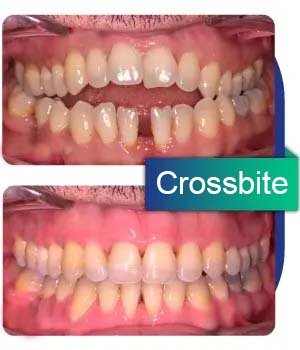
Dental Abnormalities in Children
The best time to diagnose, prevent, and treat various dental abnormalities is during childhood, with the ideal age for the first visit to an orthodontic specialist being around 7 years old. It is essential to consult a highly experienced and knowledgeable orthodontic specialist to ensure timely diagnosis and treatment of these issues. Dr. Davoudian treats a wide range of dental problems in children, from mild to complex cases.
Orthodontic Treatment Costs
Imagine that your teeth, which are firmly rooted in your gums, will be moved into their correct positions and stabilized during orthodontic treatment. It can certainly be considered a remarkable transformation. Given that this treatment is a long-term process with permanent results, one can expect the associated costs to be significant. However, it’s worth noting that Dr. Davoudian’s clinic offers flexible payment options.